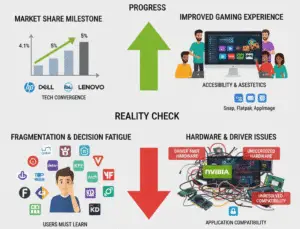
What is a VLAN? The Smart Way to Organize Your Network
Imagine your office network is like a busy highway where all types of traffic – cars (data), trucks (video), and motorcycles (voice calls) – are mixed together. A VLAN (Virtual Local Area Network) acts like special lanes that separate this traffic, making everything run smoother and safer. Let’s explore why VLANs are essential for modern networks.
VLAN Definition: Network Segmentation Made Easy
A VLAN is a virtual division of a physical network that:
-
Creates separate broadcast domains within one network
-
Groups devices logically (not by physical location)
-
Improves security and performance
-
Reduces unnecessary network traffic
Key Benefits of Using VLANs




How VLANs Work: A Real-World Example
Scenario: A hospital with:
-
Doctors needing fast access to medical records
-
Guest Wi-Fi for visitors
-
IP cameras for security
-
Administrative staff handling billing
Without VLANs:
All devices share one network, causing:
-
Security risks (visitors could access patient data)
-
Network slowdowns (cameras hogging bandwidth)
-
Chaotic management
With VLANs:
-
VLAN 10 – Medical devices (priority traffic)
-
VLAN 20 – Staff computers
-
VLAN 30 – Guest Wi-Fi (internet only)
-
VLAN 40 – Security cameras
Each VLAN operates like a separate network, even though they use the same physical switches.
Common Types of VLANs
| VLAN Type | Purpose | Example Use |
|---|---|---|
| Port-Based | Assigns VLAN by switch port | Conference room ports always on Guest VLAN |
| MAC-Based | Assigns VLAN by device MAC address | CEO’s laptop always gets Management VLAN |
| Protocol-Based | Assigns by traffic type (IP, IPX) | Separating VoIP from regular data |
| Dynamic | Assigns via authentication | Contractors get limited access VLAN |
Why Businesses Need VLANs
1. Improved Network Security
-
Finance Example: Accounting department isolated from other teams
-
Hospital Case: Patient records separated from guest Wi-Fi
2. Better Traffic Management
-
School Scenario: Prioritizes video lessons over student browsing
-
Retail Use: POS systems get dedicated bandwidth during sales
3. Simplified Compliance
-
HIPAA/PCI: Meets data isolation requirements
-
GDPR: Protects customer information
4. Flexible Work Environments
-
Hybrid Office: Same VLAN access whether in office or remote
-
Department Moves: No rewiring when teams relocate
VLAN vs Subnet: What’s the Difference?
| Feature | VLAN | Subnet |
|---|---|---|
| Layer | Data Link (Layer 2) | Network (Layer 3) |
| Separation | Logical network division | IP address division |
| Broadcast | Controls broadcast domains | Controls IP traffic |
| Best For | Local network organization | Internet routing |
Practical Difference:
-
VLAN = Separating departments in one building
-
Subnet = Connecting different office locations
Setting Up VLANs: Basic Requirements
-
Managed Switches (Unmanaged switches won’t work)
-
VLAN-Capable Router/Firewall (For inter-VLAN communication)
-
Proper Planning (Document your VLAN design)
Sample Small Business Setup:
VLAN 10 - Management (IT devices) VLAN 20 - Staff (computers/printers) VLAN 30 - Guests (internet only) VLAN 40 - VoIP Phones (priority traffic)
Common VLAN Mistakes to Avoid




The Future of VLANs
Emerging technologies enhancing VLANs:
-
Software-Defined Networking (SDN) – More flexible VLAN management
-
Micro-Segmentation – Ultra-granular security zones
-
Cloud VLANs – Extending segmentation to hybrid environments
Conclusion: Smarter Network Organization
VLANs transform chaotic networks into well-organized systems that:
-
Boost security through logical separation
-
Improve performance by reducing congestion
-
Simplify management with logical grouping
-
Support compliance requirements
Whether you’re running a small business or large enterprise, implementing VLANs is like adding traffic lanes to your network highway – everything moves faster and more safely.




